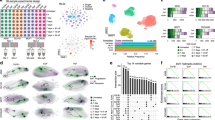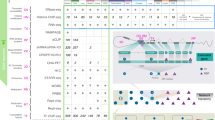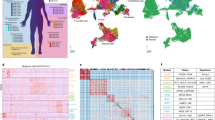Abstract
The Runx genes are important in development and cancer, where they can act either as oncogenes or tumour suppressors. We compared the effects of ectopic Runx expression in established fibroblasts, where all three genes produce an indistinguishable phenotype entailing epithelioid morphology and increased cell survival under stress conditions. Gene array analysis revealed a strongly overlapping transcriptional signature, with no examples of opposing regulation of the same target gene. A common set of 50 highly regulated genes was identified after further filtering on regulation by inducible RUNX1-ER. This set revealed a strong bias toward genes with annotated roles in cancer and development, and a preponderance of targets encoding extracellular or surface proteins, reflecting the marked effects of Runx on cell adhesion. Furthermore, in silico prediction of resistance to glucocorticoid growth inhibition was confirmed in fibroblasts and lymphoid cells expressing ectopic Runx. The effects of fibroblast expression of common RUNX1 fusion oncoproteins (RUNX1-ETO, TEL-RUNX1 and CBFB-MYH11) were also tested. Although two direct Runx activation target genes were repressed (Ncam1 and Rgc32), the fusion proteins appeared to disrupt the regulation of downregulated targets (Cebpd, Id2 and Rgs2) rather than impose constitutive repression. These results elucidate the oncogenic potential of the Runx family and reveal novel targets for therapeutic inhibition.
This is a preview of subscription content, access via your institution
Access options
Subscribe to this journal
Receive 50 print issues and online access
$259.00 per year
only $5.18 per issue
Buy this article
- Purchase on Springer Link
- Instant access to full article PDF
Prices may be subject to local taxes which are calculated during checkout






Similar content being viewed by others
Accession codes
References
Amann JM, Nip J, Strom DK, Lutterbach B, Harada H, Lenny N et al. (2001). ETO, a target of t(8;21) in acute leukemia, makes distinct contacts with multiple histone deacetylases and binds mSin3A through its oligomerization domain. Mol Cell Biol 21: 6470–6483.
Bae SC, Lee YH . (2006). Phosphorylation, acetylation and ubiquitination: the molecular basis of RUNX regulation. Gene 366: 58–66.
Baran Y, Salas A, Senkal CE, Gunduz U, Bielawski J, Obeid LM et al. (2007). Alterations of ceramide/sphingosine 1-phosphate rheostat involved in the regulation of resistance to imatinib-induced apoptosis in K562 human chronic myeloid leukemia cells. J Biol Chem 282: 10922–10934.
Bianchini R, Nocentini G, Krausz LT, Fettucciari K, Coaccioli S, Ronchetti S et al. (2006). Modulation of pro- and antiapoptotic molecules in double-positive (CD4(+) CD8(+)) thymocytes following dexamethasone treatment. J Pharmacol Exp Ther 319: 887–897.
Bleicher RJ, Cabot MC . (2002). Glucosylceramide synthase and apoptosis. Biochim Biophys Acta Mol Cell Biol Lipids 1585: 172–178.
Blyth K, Cameron ER, Neil JC . (2005). The Runx gene family: gain or loss of function in cancer. Nat Rev Cancer 5: 376–387.
Blyth K, Terry A, Mackay N, Vaillant F, Cameron E, Neil JC et al. (2001). Runx2: a novel oncogenic effector revealed by in vivo complementation and retroviral tagging. Oncogene 20: 295–302.
Blyth K, Terry A, O’Hara M, Baxter EW, Campbell M, Stewart M et al. (1995). Synergy between a human c-myc transgene and p53 null genotype in murine thymic lymphomas: contrasting effects of homozygous and heterozygous p53 loss. Oncogene 10: 1717–1723.
Blyth K, Vaillant F, Mackay N, Bell M, Jenkins A, Neil JC et al. (2006). Runx2 and MYC collaborate in lymphoma development by suppressing apoptotic and growth arrest pathways in vivo. Cancer Res 66: 2195–2201.
Breitling R, Armengaud P, Amtmann A, Herzyk P . (2004). Rank products: a simple, yet powerful, new method to detect differentially regulated genes in replicated microarray experiments. FEBS Lett 573: 83–92.
Breitling R, Herzyk P . (2005). Rank-based methods as a non-parametric alternative of the t-statistic for the analysis of biological microarray data. J Bioinform Comput Biol 3: 1171–1189.
Chaffer CL, Thompson EW, Williams ED . (2007). Mesenchymal to epithelial transition in development and disease. Cells Tissues Organs 185: 7–19.
Ducy P, Starbuck M, Priemel M, Shen J, Pinero G, Geoffroy V et al. (1999). A Cbfa1-dependent genetic pathway controls bone formation beyond embryonic development. Genes Dev 13: 1025–1036.
Durst KL, Lutterbach B, Kummalue T, Friedman AD, Hiebert SW . (2003). The inv(16) fusion protein associates with corepressors via a smooth muscle myosin heavy-chain domain. Mol Cell Biol 23: 607–619.
Edgar R, Domrachev M, Lash AE . (2002). Gene Expression Omnibus: NCBI gene expression and hybridization array data repository. Nucleic Acids Res 1: 207–210.
Fenrick R, Amann JM, Lutterbach B, Wang LL, Westendorf JJ, Downing JR et al. (1999). Both TEL and AML-1 contribute repression domains to the t(12;21) fusion protein. Mol Cell Biol 19: 6566–6574.
Fukushima-Nakase Y, Naoe Y, Taniuchi I, Hosoi H, Sugimoto T, Okuda T . (2005). Shared and distinct roles mediated through C-terminal subdomains, of acute myeloid leukemia/Runt-related transcription factor molecules in murine development. Blood 105: 4298–4307.
Huang X, Peng JW, Speck NA, Bushweller JH . (1999). Solution structure of core binding factor beta and map of the CBFalpha binding site. Nat Struct Biol 6: 624–627.
Inoue K, Ozaki S, Shiga T, Ito K, Masuda T, Okado N et al. (2002). Runx3 controls the axonal projection of proprioceptive dorsal root ganglion neurons. Nat Neurosci 5: 946–954.
Irizarry RA, Hobbs B, Collin F, Beazer-Barclay YD, Antonellis KJ, Scherf U et al. (2003). Exploration, normalization, and summaries of high density oligonucleotide array probe level data. Biostatistics 4: 249–264.
Ito Y . (2004). Oncogenic potential of the RUNX gene family: ‘Overview’. Oncogene 23: 4198–4208.
Javed A, Guo B, Hiebert S, Choi J, Green J, Zhao S et al. (2000). Groucho/TLE/R-esp proteins associate with the nuclear matrix and repress RUNX (CBF(alpha)/AML/PEBP2(alpha)) dependent activation of tissue-specific gene transcription. J Cell Sci 113: 2221–2231.
Jeffery IB, Higgins DG, Culhane AC . (2006). Comparison and evaluation of methods for generating differentially expressed gene lists from microarray data. BMC Bioinformatics 7: 359.
Jiang HM, Zhang F, Kurosu T, Peterlin BM . (2005). Runx1 binds positive transcription elongation factor b and represses transcriptional elongation by RNA polymerase II: Possible mechanism of CD4 silencing. Mol Cell Biol 25: 10675–10683.
Kilbey A, Blyth K, Wotton S, Terry A, Jenkins A, Bell M et al. (2007). Runx2 disruption promotes immortalization and confers resistance to oncogene-induced senescence in primary murine fibroblasts. Cancer Res 67: 11263–11271.
Le Stunff H, Galve-Roperh I, Peterson C, Milstien S, Spiegel S . (2002). Sphingosine-1-phosphate phosphohydrolase in regulation of sphingolipid metabolism and apoptosis. J Cell Biol 158: 1039–1049.
Levanon D, Bettoun D, Harris-Cerruti C, Woolf E, Negreanu V, Eilam R et al. (2002). The Runx3 transcription factor regulates development and survival of TrkC dorsal root ganglia neurons. EMBO J 21: 3454–3463.
Linggi B, Muller-Tidow C, van de LL, Hu M, Nip J, Serve H et al. (2002). The t(8;21) fusion protein, AML1 ETO, specifically represses the transcription of the p14(ARF) tumor suppressor in acute myeloid leukemia. Nat Med 8: 743–750.
Lou J, Cao W, Bernardin F, Ayyanathan K, RauscherIII FJ, Friedman AD . (2000). Exogenous cdk4 overcomes reduced cdk4 RNA and inhibition of G1 progression in hematopoietic cells expressing a dominant-negative CBF—a model for overcoming inhibition of proliferation by CBF oncoproteins. Oncogene 19: 2695–2703.
Lutterbach B, Westendorf JJ, Linggi B, Isaac S, Seto E, Hiebert SW . (2000). A mechanism of repression by acute myeloid leukemia-1, the target of multiple chromosomal translocations in acute leukemia. J Biol Chem 275: 651–656.
Mann R, Mulligan RC, Baltimore D . (1983). Construction of a retrovirus packaging mutant and its use to produce helper-free defective retrovirus. Cell 33: 153–159.
Miething C, Grundler R, Mugler C, Brero S, Hoepfl J, Geigl J et al. (2007). Retroviral insertional mutagenesis identifies RUNX genes involved in chronic myeloid leukemia disease persistence under imatinib treatment. Proc Natl Acad Sci USA 104: 4594–4599.
Morgenstern JP, Land H . (1990). Advanced mammalian gene transfer: high titre retroviral vectors and a complementary helper-free packaging cell line. Nucleic Acids Res 18: 3587–3596.
Osato M, Asou N, Abdalla E, Hoshino K, Yamasaki H, Okubo T et al. (1999). Biallelic and heterozygous point mutations in the runt domain of the AML1/PEBP2alphaB gene associated with myeloblastic leukemias. Blood 93: 1817–1824.
Otto F, Lubbert M, Stock M . (2003). Upstream and downstream targets of RUNX proteins. J Cell Biochem 89: 9–18.
Otto F, Thornell AP, Crompton T, Denzel A, Gilmour KC, Rosewell IR et al. (1997). Cbfa1, a candidate gene for cleidocranial dysplasia syndrome, is essential for osteoblast differentiation and bone development. Cell 89: 765–771.
Song WJ, Sullivan MG, Legare RD, Hutchings S, Tan X, Kufrin D et al. (1999). Haploinsufficiency of CBFA2 causes familial thrombocytopenia with propensity to develop acute myelogenous leukaemia. Nat Genet 23: 166–175.
Speck NA, Gilliland DG . (2002). Core-binding factors in haematopoiesis and leukaemia. Nat Rev Cancer 2: 502–513.
Stewart M, Mackay N, Cameron ER, Neil JC . (2002). The common retroviral insertion locus Dsi1 maps 30 kb upstream of the P1 promoter of the murine Runx3/Cbfa3/Aml2 gene. J Virol 76: 4364–4369.
Stewart M, Terry A, Hu M, O’Hara M, Blyth K, Baxter E et al. (1997). Proviral insertions induce the expression of bone-specific isoforms of PEBP2alphaA (CBFA1): evidence for a new myc collaborating oncogene. Proc Natl Acad Sci USA 94: 8646–8651.
Swantek D, Gergen JP . (2004). Ftz modulates Runt-dependent activation and repression of segment-polarity gene transcription. Development 131: 2281–2290.
Terry A, Kilbey A, Vaillant F, Stewart M, Jenkins A, Cameron ER et al. (2004). Conservation and expression of an alternative 3′ exon of Runx2 encoding a novel proline-rich C-terminal domain. Gene 336: 4308–4314.
Vaillant F, Blyth K, Andrew L, Neil JC, Cameron ER . (2002). Enforced expression of Runx2 perturbs T cell development at a stage coincident with beta selection. J Immunol 169: 2866–2874.
Vaillant F, Blyth K, Terry A, Bell M, Cameron E, Neil J et al. (1999). A full length Cbfa1 gene product perturbs T-cell development and promotes lymphomagenesis in synergy with MYC. Oncogene 18: 7124–7134.
Wang Q, Stacy T, Binder M, Marin-Padilla M, Sharpe AH, Speck NA . (1996). Disruption of the Cbfa2 gene causes necrosis and hemorrhaging in the central nervous systems and blocks definitive hematopoiesis. Proc Natl Acad Sci USA 93: 3444–3449.
Wotton S, Blyth K, Kilbey A, Jenkins A, Terry A, Bernardin F et al. (2004). RUNX1 transformation of primary embryonic fibroblasts is revealed in the absence of p53. Oncogene 23: 5476–5486.
Wotton S, Stewart M, Blyth K, Vaillant F, Kilbey A, Neil JC et al. (2002). Proviral insertion indicates a dominant oncogenic role for Runx1/AML1 in T-cell lymphoma. Cancer Res 62: 7181–7185.
Acknowledgements
We thank Scott Hiebert (Vanderbilt Cancer Centre, TN, USA) for RUNX1/ETO and CBFB-MYH11 plasmids, Alan Friedman (Johns Hopkins University, MD, USA) for the AML-ER plasmid and Olivier Bernard (INSERM, Paris, France) for the TEL/RUNX1 construct. We are grateful to Torsten Schaller for the murine Runx3 cDNA and to Monica Stewart and Karen Blyth for helpful comments. This work was supported by a programme grant from Cancer Research, UK, and the Leukaemia Research Fund of Great Britain.
Author information
Authors and Affiliations
Corresponding authors
Rights and permissions
About this article
Cite this article
Wotton, S., Terry, A., Kilbey, A. et al. Gene array analysis reveals a common Runx transcriptional programme controlling cell adhesion and survival. Oncogene 27, 5856–5866 (2008). https://doi.org/10.1038/onc.2008.195
Received:
Accepted:
Published:
Issue Date:
DOI: https://doi.org/10.1038/onc.2008.195
Keywords
This article is cited by
-
Combination of RUNX1 inhibitor and gemcitabine mitigates chemo‐resistance in pancreatic ductal adenocarcinoma by modulating BiP/PERK/eIF2α-axis-mediated endoplasmic reticulum stress
Journal of Experimental & Clinical Cancer Research (2023)
-
AML1/ETO accelerates cell migration and impairs cell-to-cell adhesion and homing of hematopoietic stem/progenitor cells
Scientific Reports (2016)
-
Blocking ETV6/RUNX1-induced MDM2 overexpression by Nutlin-3 reactivates p53 signaling in childhood leukemia
Leukemia (2014)
-
The RUNX family in breast cancer: relationships with estrogen signaling
Oncogene (2013)
-
Mesenchymal stem cells in joint disease and repair
Nature Reviews Rheumatology (2013)



